Methodism in Batford dates back to 1884, when a few cottages on the road between Luton and Wheathampstead housed workers at local farms and the flour mills on the banks of the River Lea. A footbridge had by then replaced what had, since Roman times, been a ford over the river at Cold Harbour.
There lived a Mr and Mrs Josiah Smart, who were devoted Wesleyan Methodists and who, with their children, would each Sunday make their way up Ox Lane, down Sun Lane across the railway to attend the chapel at Leyton Road.

Batford Methodist Church, opened in 1905. Credit: Alan Bunting, March 2015
Methodism had its regular ‘class’ meetings for scripture study, and Mrs Smart was assigned to the class held by Mrs Henry Salisbury, mother of the artist Frank Salisbury. As time passed, she found the long walk up over the hill from Batford increasingly onerous and she was granted permission to instigate a class meeting nearer to her home at Cold Harbour.
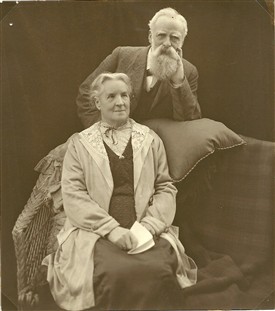
Henry and Susan Salisbury, c.1910. Credit: LHS archives
Together with her young daughters, Mrs Smart started a regular open-air Methodist meeting at the junction of Bowers Heath Lane and Lower Luton Road. With the coming of winter, not unnaturally, indoor accommodation was needed and intially the Smarts made their own home available for the purpose and regular Sunday evening services began.
Mr Robert Drury, who lived nearby in Cold Harbour Lane, opened his cottage for a morning Sunday School. But so successful were the local Methodist ventures, that they quite rapidly outgrew the space the two private homes could provide. Clearly funds were required to establish a purpose-made place of worship.
Harpenden at that time came within the the purview of Luton’s Chapel Street Methodist ‘circuit’ and Mr and Mrs Salisbury duly sought financial and other support from Chapel Street ministers and preachers, as well as from more well-known and well-heeled Harpenden Methodists, in setting up a trust, administered by secretary Mr Joseph Lewin.
The first ‘tin’ church
A corrugated iron chapel was duly erected on the piece of ground between Mr Drury’s cottage and his erstwhile next door neighbour, the trust secretary Mr Lewin. It came into use in 1884 and it was not long before nearly every child in the Batford/Cold Harbour neighbourhood – between 30 and 40 in number – was enrolled in the morning Sunday School.
There was no lack of willing helpers. Among them were Miss Susie Salisbury and a Miss Willis, whose father became the first Sunday School Superintendent. They all walked down from Harpenden each Sunday morning.
Afternoon and evening services were conducted by Methodist ministers and local preachers from Harpenden as well as from elsewhere in the Luton Chapel Street circuit. The latter regularly included the circuit’s ‘second minister’, the Rev S T Bosward. Preachers coming from Luton either walked or came by pony-and-trap, but only occasionally by train, to nearby Harpenden East station. Local preachers included John Tearle, William Rumbles, Arthur Gregory and Sydney Wingrave.
Those inside the completely uninsulated ‘tin’ chapel inevitably suffered on hot summer days as well as from the cold in winter. It was also noted that if there was a heavy rainstorm during a service, the preacher’s voice would be completely drowned by the noise. On more than one such occasion, perhaps to the relief of some members of the congregation, the sermon had to be abandoned.
A congregation of between 40 and 50 people could be expected regularly on Sunday evenings. During the week a Band of Hope meeting was held, led – if his work duties as a signalman on the Great Northern Railway permitted – by Mr Drury. The Band of Hope movement, founded by the Rev Jabez Tunnicliffe in Leeds in 1847, promoted temperance, striving to persuade, young people especially, of the evils of alcohol.
Growing congregation
By the turn of the century, it became evident that a larger building was needed. The local population was growing. New houses had been built along the Lower Luton Road and in nearby Salisbury Road, Southview Road and Batford Road, as well as in Marquis Lane on the other side of the river.
At a church trustees’ meeting in February 1900, a minute was recorded: ‘That Mr Knowles, solicitor, be requested to purchase and convey to the Trustees a piece of land situated on the Batford Mill estate as a site for a new chapel now being held by Mr S Wingrave for that purpose, the price being £33’. The church steward was requested to have a notice put up on the land proclaiming ‘Site for New Wesleyan Church’. The minutes were signed ‘George E Scott, February 18 1901’.
There were many difficulties to be overcome, quite apart from raising the necessary funds. Geographical Methodist ‘politics’ were involved. The boundary between two different Luton church circuits, namely Chapel Street and Waller Street, was deemed to be the River Lea. Moving the church’s location from Cold Harbour to the Lower Luton Road site took it into Waller Street territory. Clearance was therefore required from the Methodist Conference authorities in London which – such was, and remains today, the way of bureaucracy – took time.
Three years went by until, in June 1904, plans for the new church were drawn up. Under the chairmanship of the Rev T Moorhouse Thorp, the church trust was renewed. Mr Drury was appointed secretary of the project, with Mr Wingrave as treasurer. Eight new names were included among the trustees: T Bigg, A Gregory, J Hawkes, A Hall, E Nott, H E Salisbury, H O Williams, and S Wingrave.
The plans, prepared by Messrs Anscombe and Franklin, were accepted at a cost of £591. The stone-laying took place on September 13 1904. Messrs Goldhawk and Son of Kimpton were contracted to undertake the building work. A tablet in the front porch recorded the names of Mrs Henry Salisbury, Mrs J Tearle, Mrs S Wingrave and H O Williams.
Official opening in 1905
The new Batford Methodist Church was officially opened on January 25 1905. The old corrugated iron chapel had been sold for £25, but it nevertheless remained available as the venue for a celebratory tea, where Mrs George Richardson, a daughter of Mrs Smart, later remembered making paper flowers to decorate the tables.
The only possible lighting was by oil lamps, there being no gas laid on at Batford. There was a small vestry partitioned off from the church, but the thin wall between was anything but soundproof, as soon became apparent when the Sunday School primary department was in session in the vestry, under the supervision of Miss Susie Salisbury. She was assisted by her brothers and sisters, who had performed a similar role at Cold Harbour.
Later on, for several years, her nephews and nieces, with their friends, formed an enthusiastic band of young people, giving valuable help in establishing what became a thriving Sunday School. Those children above primary age met in the main church, boys on one side of the aisle, girls on the other.
Mrs Edwin Nott, with willing helpers from Harpenden’s Methodist Church, established a Women’s Meeting on Monday afternoons. It flourished and eventually became known as the Sisterhood.
Clearing the debt
In 1911, at the annual trustees meeting, with the Rev Wesley Woolmer in the chair, it was reported that the debt on the church stood at £120, with the mortgagee pressing for repayment. Mr Arthur Hall, who had taken on the trust secretary post from his father-in-law Mr Wingrave, was asked to help. He began by transferring his church membership from Harpenden to Batford, and then organising a weekly gift scheme.
Even so, the debt was not cleared until 1917. By then mains gas had been installed, enabling the church’s smelly oil lamps to be replaced, much to the appreciation of evening congregations.
In 1912, after a lot of discussion and some controversy, a morning service replaced the previous afternoon service, enabling more flexible use to be made of the premises by the expanding Sunday School activities. Numbers of children attending the Sunday School continued to grow yet further, to the point where, in February 1914, a trustees’ meeting was held to consider proposals for a new school hall to be built adjoining the rear of the church, at an estimated cost of £300.
A garden party was held in Mrs Henry Salisbury’s garden in Arden Grove, Harpenden, to initiate the necessary fund-raising programme. But with the onset of the First World War in August, Batford’s church extension plans, like many other projects at the time, had to be put on hold. Nevertheless, during the war years, social activities centred on the church continued apace, with the setting up of first a girls’ club and then an equivalent organisation for the boys. Both were kept busy, notably organising concerts, held – because there was no alternative – in the main church.
Plans for a Sunday school hall
Soon after the November 1918 Armistice, the plans to build a school hall were revived, although the war had stimulated unwelcome inflation and the likely cost had increased to £1000. Over the next two years, a debate ensued as to whether a less costly temporary building should be erected. But the trustees took the long view and voted to have a permanent school hall built, albeit utilising the rear wall of the existing church structure as a means of reducing the expense.
Undaunted, Batford members set about raising funds through traditional church means: holding concerts, jumble sales and the like. A stone-laying ceremony for the new hall was arranged for October 21 1921. Bricks were laid by Sunday School scholars, each of whom had raised five shillings for the building fund, the ‘reward’ for which was having his or her initials engraved on the nominated brick. Other bricks were laid by three local Methodist ministers officiating at the ceremony.
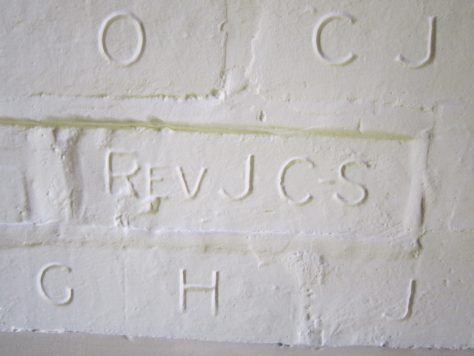
Embossed commemorative brick in the rear wall of the school room, 1922 – initials of Rev. J Crowle-Smith. Credit: Alan Bunting, March 2015
Batford at the time enjoyed the luxury (by present standards) of having its own superintendent minister, the Rev C Cartwright, as well as a second minister, the Rev J C Chapman. Also in attendance was the Harpenden church minister, the Rev J Crowle-Smith. On January 26 1922, the new hall was opened during a special afternoon service led by the Rev Graham Payn.
A month before, a major step had been taken towards the financial target when the sum of £150 was raised by a sale of work at Harpenden Methodist Church at Leyton Green. A similar fund-raising event was held the following autumn in the new room at Batford, when a sum of £80 was realised which, together with generous help and gifts from friends all over the circuit, allowed the debt to be cleared by February 1923.
The new hall was at once put to full use, accommodating the main Sunday School, though with the primary scholars continuing to meet in the church and a senior girls’ class in the old vestry. Mr James Clark became the first Sunday School Superintendent, followed by Mr Stanley Munt, a resident of Batford Road, who was to maintain his strong connections with the church right through to the 1960s.
The inter-war years
During the inter-war years, weekday activities on Batford Methodist Church premises proliferated, though growth was held back by the virtual absence of new house building in the immediate area; the local population remained largely static. Nevertheless a successful Boys’ Club was started by Percy and Frank Hall. It boasted two football teams.
Sunday services were enhanced by a buoyant choir, led by Mr Cecil Hawes, supported by Miss B Cockshott and Miss G Richardson as organists. From the mid-1930s evening services drew large congregations, following refurbishments to the building which included improved heating and new blue curtains and carpets.
At the outbreak of war in 1939, with many members called away on National Service or on other emergency duties, ongoing church life became a challenge. However wartime exigencies brought a number of Methodist newcomers to the area. A new Harpenden postmaster, Mr H C Cross, had been appointed a few months earlier; he and his wife soon became immersed in Batford’s church activities. Other wartime newcomers were Fred and Phyllis Lee who went on to become pillars of the church for the next 30 years or more.
Interestingly, the perhaps more comfortably ‘homely’ feel of Batford attracted congregation newcomers who lived nearer to the much bigger but perhaps, to them, more impersonal High Street Methodist Church (opened in 1930).
As documented elsewhere on the history society website, on Sunday May 12 1941 Batford Methodist Church was hit by one of a stick of German incendiary bombs. The burnt-out roof was replaced by a not-wholly-weatherproof temporary structure which remained in place for several years.
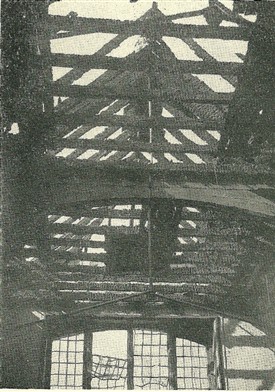
The burnt-roof of Batford Methodist Church. Credit: LHS archives – scan from press cutting : BF 26B.7
During the immediate post-war period the most momentous development affecting Methodism in Batford was the building of hundreds of new council houses and flats on the high ground behind the church. Pickford Hill, Porters Hill, Milford Hill and the numerous minor roads on the new Batford estate yielded many new church members and Sunday School pupils.
Further expansion

Mrs Owen Green opening the new hall, designed by George Herring. Credit: LHS archives – BF52 – George Herring’s newspaper cuttings
As a result the need arose to extend the church premises further which, because of the limitations of the site, meant building upwards. At a cost estimated originally at £2500, but which eventually came to £4750, a second storey was added to the rear schoolroom. Opened on March 15 1952, it included a new minister’s vestry and a roomy kitchen, as well as boasting a modern boiler-fed heating installation.
The resulting debt was paid off through a weekly church member gift scheme, bringing in about £100 per year, supplemented by individual donations and sales of work. Though not until early 1957 was the treasurer Mr F M Cheshire able to announce the clearance of the debt.
Three years later additional funds of about £450 were raised to cover the cost of refurbishing the church interior, which some members had criticised as being rather drab. The dark woodwork of the pulpit and lower walls were covered in a new light-oak veneered board and the window frames were painted white.
A new oak communion table was acquired, with new blue curtains hung behind it. Batford’s minister at the time, the Rev Tom Mayhew, who in his own words was ‘a bit of a carpenter’, made a new hymn board and a wooden cross on the wall above. The father-and-son Ward family blacksmiths at Batford Forge designed and made new scrolled ironwork supports for the communion rail.
During the 1970s further upgrades of the church premises took place. In 1974 it was decided to replace the original dark stained pews with more easily handled interlocking chairs, at a cost of £1000, partially funded by members and friends making interest-free loans or paying for individual chairs. A bumper bazaar, held in High Street Methodist’s church hall, raised an impressive £550 towards Batford’s church seating fund.
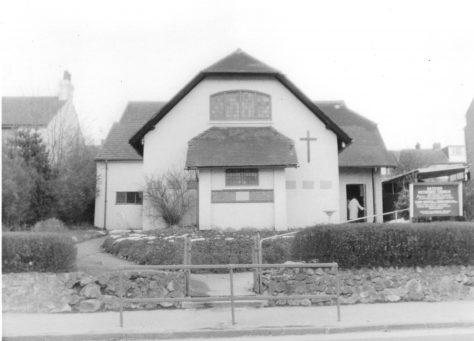
Batford Methodist church, c.1970. Credit: LHS archives
Those enhancements to the church interior led to aspirations of another innovation: the replacement of the existing long-serving piano with an organ, a specific organ fund having been launched some time before. Various different instruments were considered before the decision was made to purchase, at an estimated cost of £900, an electric organ built locally by Mr John Howard, a member of Batford’s sister church at The Folly, Wheathampstead.
In 1984, Batford Methodist Church clocked up its first centenary, with a number of celebratory events, attended by many of those ministers and preachers who had helped sustain its life in the local community during diffficult and challenging times. Thirty years later it continues its dedicated work.
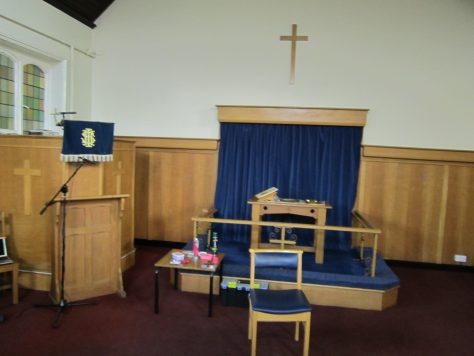
Batford Methodist Church – chancel. Credit: Alan Bunting, March 2015

No Comments
Add a comment about this page